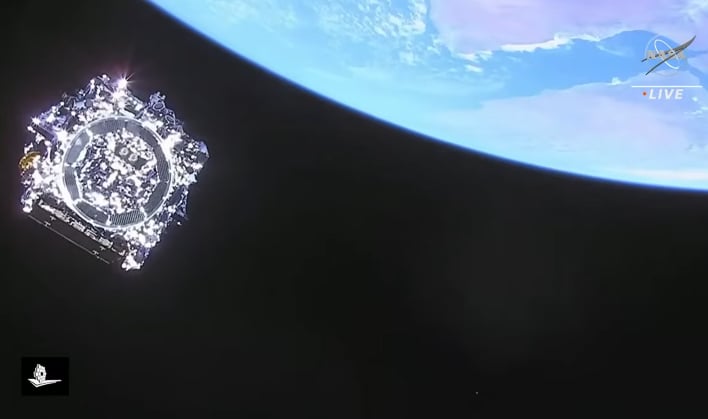Track The James Webb Space Telescope In Real Time As It Explores Our Solar System

Update (12/27/21):
Now that the James Webb Telescope has successfully left Earth to go make all kinds of cool discoveries, we can track its progress in real-time with a nifty dashboard showing its progress as it zooms through space. Here it is...
Check out that cruising speed—it's zipping through space at a breakneck 0.7589 miles per second at the time of this writing, and has so far traveled over 243,300 miles from Earth. It still has around 655,000 miles to go before it reaches its destination, Lagrange Point 2 (LP2), which is around 1 million miles away from Earth.
The JWST performed its first course correction burn on Christmas Day, followed by another today and a final burn on Day 29 as it approaches its destination.
So far it seems everything has gone as planned, or close to it, with no major hiccups reported. Knock on wood that continues to be the case.
Original Article:
The highly anticipated James Webb Space Telescope (JWST) had a successful Christmas morning launch. Now the world watches as the $10 billion telescope begins its first 29 days before orbit insertion, on its 1 million mile journey from Earth.
JWST has been one of the most highly anticipated launches in recent NASA history. The advanced instruments on the observatory are expected to begin unlocking and revealing secrets of our universe as it works alongside its predecessor, the Hubble Telescope. After experiencing a couple of delays due to weather conditions and an unforeseen incident during testing, JWST has finally made its way into the great expanse of space.
NASA and its international partners, the European Space Agency (ESA) and the Canadian Space Agency, all watched as JWST launched from French Guiana, South America this morning. It was taken into space by Arianespace's Ariane 5 rocket and teams back on the ground received the first telemetry data transmissions from JWST just 5 minutes after launch. The Ariane 5 rocket separated from the observatory 27 minutes into the flight at an altitude of approximately 75 miles (120 km), and then returned itself back to Earth successfully.
Around 30 minutes post launch, Webb unfolded its solar array and mission managers confirmed that it was providing power to the observatory. Following the unfolding of the solar array, mission operations will establish a communications link with the observatory through the Malindi ground station in Kenya, and ground control at the Space Telescope Science Institute in Baltimore will then send the first commands to the spacecraft.
Approximately 12 hours and 30 minutes after launch, engineers and ground controllers will execute the first of three mid-course correction burns by firing JWST's thrusters to position the spacecraft on an optimal trajectory toward its destination in orbit which will take it 1 million miles from our planet, Earth.

JWST is slated to explore every phase of cosmic history with its revolutionary technology. It will be attempting to reveal imagery and data from within our own solar system to the most distant of galaxies in the early universe. Teams are hoping to answer questions about quasars and the supermassive black holes that produce them.
Thomas Zurbuchen, associate administrator for the Science Mission Directorate at NASA Headquarters in Washington added, "I want to congratulate the team on this incredible achievement. Webb's launch marks a significant moment not only for NASA, but for thousands of people worldwide who dedicated their time and talent to this mission over the years. Webb's scientific promise is now closer than it ever has been. We are poised on the edge of a truly exciting time of discovery, of things we've never before seen or imagined."
We at HotHardware also want to congratulate all the people that have worked so fervently on the James Webb Space Telescope. Some have spent their entire careers on this one project and to have watched all that hard work finally make its way into space this morning must have been an incredible feeling. As we all watch from the edge of our seats for JWST to complete its first 29 days of critical and complex sequence of events, we applaud the hard work and dedication of NASA and its international partners. A new chapter into our journey into understanding our universe and beyond has just begun.

